Intrinsicly evisculate emerging cutting edge scenarios redefine future-proof e-markets demand line
Gallery Posts






Working Hours
| Mone - Fri: | 09:00 - 06:00 |
|---|---|
| Saturday: | 09:00 - 12:00 |
| Sunnday | 09:00 - 04:00 |
| Monday | 09:00 - 05:00 |
As part of the development process, the Design phase lays the foundation for the remaining phases, resulting in a blueprint for further development and testing phases. Most solution providers use the waterfall life cycle approach for software solution development. The waterfall approach (refer Figure 14.3) helps to understand the extent of the residual risks and allows one to work conscientiously toward reducing those risks.

Knowing the benefits and drawbacks of a system development life cycle will aid you in making the best decision for your system. This can include resolving new issues that arise as a result of user reports or dealing with leftover bugs that were not able to be corrected before launch. In comparison to smaller systems, larger systems may require more maintenance phases.
At the end of the development phase, the systems might look fully operational, but it is important that they are first tested before going live. This irons out any kinks in the systems to make sure that it is working as perfectly as it should be. In the testing phase, the system should undergo critical scrutiny in different scenarios. If any bugs or issues are found, the team should set to resolve them without upsetting the rest of the system.
It’s easy to identify and manage risks, as requirements can change between iterations. However, repeated cycles could lead to scope change and underestimation of resources. It may also be helpful to choose your first software language to learn. Languages like C# and Java are still in demand by employers, but many new languages are emerging, too. Before choosing a language, you need to know what you want to code, but simple front-end development languages like JavaScript, HTML, and CSS are good places to start. The Smartsheet platform makes it easy to plan, capture, manage, and report on work from anywhere, helping your team be more effective and get more done.
Typically, the more steps defined in an SDLC model, the more granular the stages are. Software development managers will utilize SDLCs to outline various development stages, make sure everyone completes stages on time and in the correct order, and that the project is delivered as promptly and as bug-free as possible. Since SDLCs have well-structured documents for project goals and methodologies, team members can leave and be replaced by new members relatively painlessly.

Different sections of the software should also be tested to ensure that they operate together seamlessly-performance testing, to eliminate any processing glitches and bugs. As soon as the system is deployed and used by end-users, the Enhancement (Upgrade) phase occurs. During this phase, the system is continuously being updated to ensure that it remains relevant and useful to end-users and continues to meet their changing needs. As part of a continuous improvement process, the Enhancement (Upgrade) phase provides a chance to continuously improve the system.
In IT, the term “life cycle” was first used in the 1950s and 1960s to describe the stages involved in developing a new computer system, but it is now commonly used to refer to all stages in the production of any type of software [1]. There are seven stages in the SDLC and six common models that are used for different projects. In this guide, we’ll go through each stage and model to give you an overview of what becoming a software developer entails.
Many of these vendors also have a strong focus on identifying and de-bugging systems that may support the process of testing in software development life cycles. In many cases, SDLC teams utilize a variety of software solutions to support the varying stages. For example, requirements may be gathered, tracked and managed in one solution while testing use cases may take place in a completely different solution. Phase 7 of the systems development life cycle assesses and ensures that the system does not become obsolete.
It ensures that the software is secure from initial design to final delivery and can withstand any potential threat. During DevSecOps, the team undergoes security assurance activities such as code review, architecture analysis, penetration testing, and automated detection, which are integrated into IDEs, code repositories, and build servers. However, unlike traditional software development system development life cycle phases that addresses security as a separate stage, SDLC addresses security every step of the way through DevSecOps practices. System Design is a critical stage in the SDLC, where the requirements gathered during the Analysis phase are translated into a detailed technical plan. It involves designing the system’s architecture, database structure, and user interface, and defining system components.
In the information systems domain, the terms SDLC and system life cycle are often used interchangeably. It has been suggested that information SDLC should not be confused with system (the delivered product) life cycle. The system life cycle begins when the SDLC delivers the https://www.globalcloudteam.com/ final product, that is, when the implementation phase begins. The objective of this activity is to extend as long as possible the life cycle of an existing system. When this is not longer feasible or efficient, the system life cycle terminates and a new SDLC commences.
In contrast, the waterfall model may be more appropriate for low-risk projects where requirements are well understood and potential bugs can be identified more easily. The systems development life cycle originally consisted of five stages instead of seven. These included planning, creating, developing, testing, and deploying. Phase 3 of the systems development life cycle describes the desired features and operations of the system.

This word has been around for many decades and stems from a time when organizations were much more centralized. Still, as IT as a field and IT services as a market have evolved, SDLC has become an integral aspect of how custom software development company develop software solutions. An extension of the waterfall model, this SDLC methodology tests at each stage of development. Popular SDLC models include the waterfall model, spiral model, and Agile model. The System Development Life Cycle encompasses a series of interconnected stages that ensure a systematic approach to system development.
ALM includes the entire lifecycle of the application and continues beyond SDLC. The document sets expectations and defines common goals that aid in project planning. The team estimates costs, creates a schedule, and has a detailed plan to achieve their goals. After training, systems engineers and developers transition the system to its production environment.